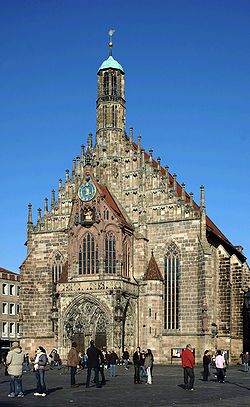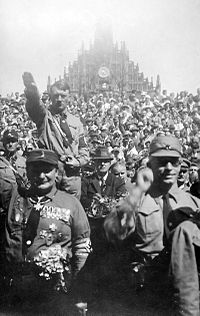- Nuremberg Frauenkirche
-
Frauenkirche
Church of Our Lady
West facade of the Frauenkirche
Basic information Location Nuremberg Affiliation Roman Catholic Year consecrated 1358 Ecclesiastical or organizational status Parish Church Architectural description Architectural type Church Architectural style Gothic Direction of façade W Groundbreaking 1352 Completed 1361 The Frauenkirche (in English, "Church of Our Lady") is a church in Nuremberg, Germany. It stands on the eastern side of the main market. An example of brick Gothic architecture, it was built on the initiative of Charles IV, Holy Roman Emperor between 1352 and 1362. The church contains many sculptures, some of them heavily restored. Numerous works of art from the Middle Ages are kept in the church, such as the so-called Tucher Altar (c. 1440, originally the high altar of the Augustinian church of St. Vitus), and two monuments by Adam Kraft (c. 1498).
Contents
History
The church was built in the grand market, in place of the former Jewish synagogue, which was destroyed during the pogrom of 1349 (which followed an outbreak of Black Death). The architect was probably Peter Parler. Charles IV wanted to use the Frauenkirche for imperial ceremonies, which is reflected in the porch with the balcony, and in the fact that the church is relatively unadorned except for the coats of arms of the Holy Roman Empire, the seven Electors, the town of Nuremberg, and the city of Rome, where the Holy Roman Emperors were crowned.
Charles IV's short-lived son Wenceslas was baptized in the church in 1361, on which occasion the Imperial Regalia, including the imperial reliquaries, were displayed to the people. Beginning in 1423, the Imperial Regalia was kept permanently in Nuremberg and displayed to the people once a year on a special wooden platform constructed for that purpose.
Architecture
Frauenkirche is a hall church with two aisles and a tribune for the emperor. The church contains nine bays supported by four columns.
The triforium, named the Imperial Loft or St. Michael's Loft, opens on to the nave by means of an arcade, the arches of which are filled with floating tracery, consisting of three rosettes supported by a segmental arch.
The narthex of the church contains tracery. All three sides of the narthex have portals, the jambs and archivolts of which are decorated with sculptures. The gable contains many niches, which used to house sculptures.
Männleinlaufen
One of the most notable features of the church is the "Männleinlaufen", a mechanical clock that commemorates the Golden Bull of 1356. The clock was installed in the church in 1506. The Holy Roman Emperor is shown seated with the prince-electors surrounding him.
Modern history
In The Triumph of the Will, Leni Riefenstahl's 1934 propaganda film about the 1934 Nuremberg Rally, the final scene consists of a military parade through downtown Nuremberg, with Adolf Hitler shown receiving salutes from Nazi troops with the Nuremberg Frauenkirche in the background.
References
- This page is based on the article on German Wikipedia.
 Adolf Hitler with the Nuremberg Frauenkirche in the background, 1928.
Adolf Hitler with the Nuremberg Frauenkirche in the background, 1928. Categories:
Categories:- Roman Catholic cathedrals in Germany
- Cathedrals in Germany
- Imperial cathedrals
- Gothic architecture in Germany
- Churches in Bavaria
- Buildings and structures in Nuremberg
- Visitor attractions in Nuremberg
- Charles IV, Holy Roman Emperor
Wikimedia Foundation. 2010.


